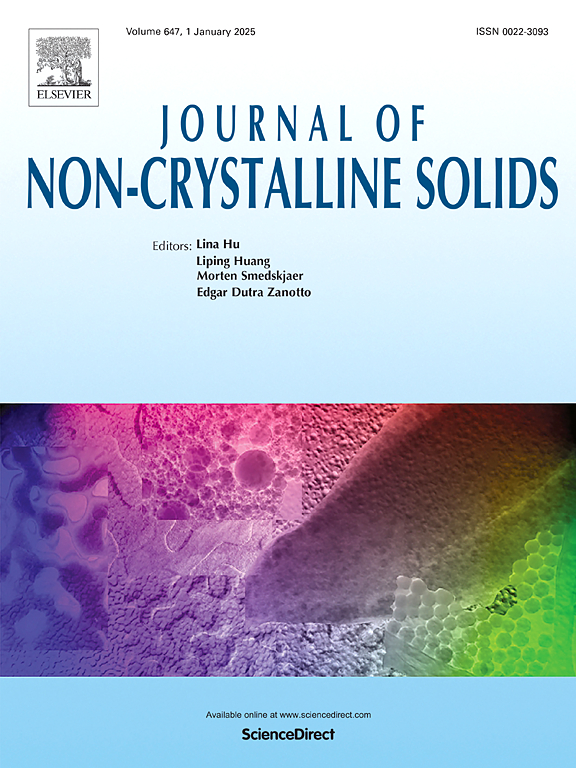富Al2O3熔体中Al3+的配位演化与稳定性:由碱性氧化物类型(M=Ca, Mg, Fe)和MO/Al2O3比例调节
IF 3.5
3区 材料科学
Q1 MATERIALS SCIENCE, CERAMICS
引用次数: 0
摘要
作为两性氧化物,Al2O3在铝硅酸盐熔体中的结构行为是复杂的。目前对Al3+在不同碱性氧化环境下的配位结构的了解仍然有限。本研究采用分子动力学模拟研究了不同碱性氧化物类型(CaO, MgO, FeO)和浓度(MO/Al2O3= 0.25-3) MO- sio2 -Al2O3熔体中Al3+的配位结构和稳定性。结果表明,不同碱性氧化物对Al3+的电荷补偿能力不同:Ca2+的CaO/Al2O3=0.5, Fe2+的FeO/Al2O3=1.0,而Mg2+即使在MgO/Al2O3比超过3.0时也不能实现电荷平衡。动力学寿命分析表明,只有四面体配位的[SiO4]和[AlO4]具有显著的结构持久性。氧键分析表明,Si-O-Si结构具有最高的持久性,大大超过Si-O-Al和Al-O-Al结构。这些结果从根本上阐明了Al3+在不同碱性环境中的结构行为及其对高al2o3铝硅酸盐熔体性能的调控意义。本文章由计算机程序翻译,如有差异,请以英文原文为准。
Coordination evolution and stability of Al3+ in Al2O3-rich melts: Modulated by alkaline oxide type (M=Ca, Mg, Fe) and MO/Al2O3 ratio
As an amphoteric oxide, the structural behavior of Al2O3 in aluminosilicate melts is complex. Current understanding of the coordination structure of Al3+ in different alkaline oxide environments remains limited. This study employed molecular dynamics simulations to investigate the coordination structure and stability of Al3+ in MO-SiO2-Al2O3 melts with different alkaline oxide types (CaO, MgO, FeO) and concentrations (MO/Al2O3=0.25–3). The results indicate that different alkaline oxides exhibit varying capabilities in achieving charge compensation balance for Al3+: CaO/Al2O3=0.5 for Ca2+ and FeO/Al2O3=1.0 for Fe2+, whereas Mg2+ cannot achieve charge balance even at MgO/Al2O3 ratio exceeding 3.0. Kinetic lifetime analysis reveals that only tetrahedrally coordinated [SiO4] and [AlO4] exhibits significant structural persistence. Oxygen linkage analysis shows that Si-O-Si structures possess the highest persistence, substantially exceeding Si-O-Al and Al-O-Al structures. These results fundamentally elucidate the structural behavior of Al3+ in different alkaline environments and their implications for regulating the properties of high-Al2O3 aluminosilicate melts.
求助全文
通过发布文献求助,成功后即可免费获取论文全文。
去求助
来源期刊

Journal of Non-crystalline Solids
工程技术-材料科学:硅酸盐
CiteScore
6.50
自引率
11.40%
发文量
576
审稿时长
35 days
期刊介绍:
The Journal of Non-Crystalline Solids publishes review articles, research papers, and Letters to the Editor on amorphous and glassy materials, including inorganic, organic, polymeric, hybrid and metallic systems. Papers on partially glassy materials, such as glass-ceramics and glass-matrix composites, and papers involving the liquid state are also included in so far as the properties of the liquid are relevant for the formation of the solid.
In all cases the papers must demonstrate both novelty and importance to the field, by way of significant advances in understanding or application of non-crystalline solids; in the case of Letters, a compelling case must also be made for expedited handling.
 求助内容:
求助内容: 应助结果提醒方式:
应助结果提醒方式:


